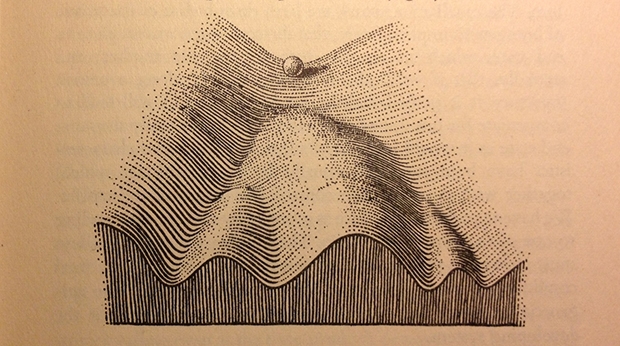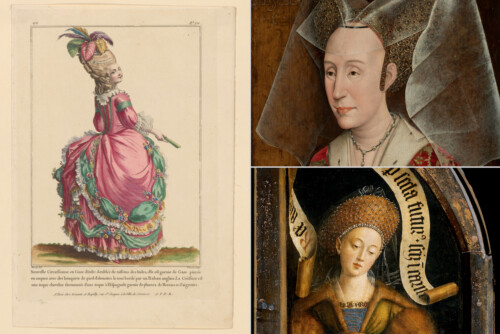The World Egg
To the “highly poetic metaphysics” of those schoolboy images Waddington added as an adult the philosophy of Alfred North Whitehead. 27 Whitehead, “a philosopher of systems in the process of becoming,” was inspiring to Waddington, an embryologist-in-the-process-of-becoming-developmental-biologist who was particularly drawn to his notions of “system, process, and the creative advance into novelty.” 28 Feeling himself encircled by pragmatic materialists, Waddington drew on Whitehead’s work to formulate alternatives to the Newtonian physics that dominated science of the time, which he described as “conceptions of billiard-ball atoms existing at durationless instants in an otherwise empty three-dimensional space.” 29 As he began to investigate an interactionist ontology, he found particularly important Whitehead’s notion that “[t]he raw materials from which we start to do science . . . are occasions of experience,” each “essentially infinite and undenumerable,” a “unity” comprising “an experiencing subject and an experienced object” that can be differentiated only heuristically and artificially and that has “a duration in time.” 30
In particular, Waddington found in Whitehead’s metaphysics an anticipation of quantum theory: “the idea that a particle must be thought of as a wave function extending through the whole of space time.” 31 Whitehead’s central notions of “concrescence”—“the coming together of the constituent factors in an event” and “prehension”—“the way an event here and now incorporates into itself some reference to everything else in the universe in accordance with its own ‘subjective’ feeling,” fascinated him. As he told the Symposium participants, he credited them with shaping both his choice of experimental problems and his manner of solving them. 32
Waddington referred in particular to the groundbreaking series of experiments on living chick embryos that he carried out between 1930 and 1940: splicing, slicing, implanting, stirring, and shaking them in order to find out how the intervention affected embryonic development. 33 He explains to the Symposium participants, “In the late thirties I began developing the Whiteheadian notion that the process of becoming (say) a nerve cell should be regarded as the result of the activities of large numbers of genes, which interact together to form a unified ‘concrescence.’” 34 In these experiments he explored how embryonic cells are induced to develop into a specific type of organ or tissue, though he acknowledges that he was “[i]nfluenced—probably over-influenced—by genetics.” If he had been “sufficiently Whiteheadian,” he acknowledges, he might have backed away from his single-minded focus on genetics to explore the crucial role played by the concrescence itself: the way all of the constituent factors of the event came together in one unique event. 35
Despite their over-attention to genetics, these experiments with cultured chick tissues had a transformative effect on modern biology, demonstrating the plasticity of living matter and the possibility that biological time and space could be operationalized—that is, detached from context, manipulated and engineered to a specific end. 36 We can trace back to Waddington’s experimental work in the 1930s and 1940s the realization that embryonic development was guided not merely by the DNA in the nucleus of the cell but also by the interactions between the cell nucleus and its surroundings, both the cytoplasm and the extracellular environment. The implications were far-reaching: what Waddington had realized was that cellular changes in response to the environment (both within the cell and surrounding the organism) could be passed to the next generation. 37
Waddington coined the term to describe this new area of study in his 1942 essay, “The Epigenotype.” “We might use the name ‘epigenetics’,” he suggested, for studies dedicated to discovering “the causal mechanisms at work, and to relate them as far as possible to what experimental embryology has already revealed of the mechanics of development. 38 He was convinced that biologists needed a theory to explain the relationship between the genotype and the phenotype, that is between the complete hereditary information of an organism and the organism’s actual properties as they can be observed, including not only their development but also their morphology and behavior. Unlike both embryology and genetics, he argued, epigenetics could account for this relationship both at the cellular level and at the level of whole organisms, and even of populations. To convey the broader theoretical and pragmatic capability of this new field, Waddington created “a visual depiction of a set of developmental choices that is faced by a cell in the embryo.” 39 He called this the epigenetic landscape, a schematic image of the way these relations could shape and channel development over time.

Yet Waddington excluded something from his thinking about these issues, thus curtailing the potential depth of his understanding of developmental processes. It has to do with affect, attention, perhaps even the affective and sensory registers of prehension. Waddington admits to finding “[u]nsettling, even perhaps a bit sinister” [my italics] the notion that “‘things’ are essentially eggs—pregnant with God-knows-what.” 40 His response here is complex, and worth parsing. As he narrates it, the world egg arouses a complex mixture of emotions in him: mastery (he describes it as “simple enough, with a bland, definite shape”), detachment from its alterity (he describes as “rather impenetrable”), and surprise (produced, he explains, by encountering the fluffy yellow chick which hatches from the world egg, runs about, may even imprint on him if given “half a chance”). 41
The chick pays attention to him, and he finds that unsettling. Waddington’s wording suggests that he would like to resist the chick’s imprinting, perhaps because both the chick and the human being are changed by their encounter. At first he asserts that the world egg idea “infiltrated” his experiments, but then in a classically Freudian act of negation he denies it, as he also denies the Whiteheadian notions of concrescence and prehension: “[Although] privately my own thought runs along similar lines […] I do not see that they have had any direct influence on the way in which I have conducted my experimental work.” 42
Note what Waddington is doing here. Although asserting in his formulation of epigenetics that we should understand model experimental subjects (like those chick embryos) not as autonomous entities but as entangled processes always changing in response to the environment, he is resisting the other half of that proposition, which would be to apply that understanding to the experimenter himself. He omits the reflexive turn that would entail exploring the impact of scientific work on the experimenter and on the human community as well as on the experimental subject. This exclusion of affect, attention, and prehension excludes certain phenomena from consideration, limits his concept of epigenetics, and narrows significantly the applications of epigenetic theory.
Waddington explains this retreat from metaphysics to the seemingly more solid ground of experimental science thus: “all of us who want to understand living systems in their more complex and richer forms are fated to look like suckers to our colleagues who are content to make a quick (scientific) buck wherever they can build up a dead-sure pay-off.” 43 But there’s more than that behind his experimentalist focus, he confides: “Since I am an unaggressive character, and was living in an aggressively anti-metaphysical period, I chose not to expound publically these philosophical views.” 44 The effect of this retreat from the philosophical implications of his theory marks contemporary biology as well, according to Linda Van Speybroeck. “[T]oday’s epigenetics more and more offers the possibility to enfeeble biological thinking in terms of genes only, as it expands the gene-centric view in biology by introducing a flexible and pragmatically oriented hierarchy of crucial genomic contexts that go beyond the organism.” 45 At the second Serbelloni Symposium, Waddington backed away from the implications of his vision, leaving us with the reductive, deterministic, gene-centered epigenetics of today, in which physicians screen for BRCA1 genes, but the institution of industrial medicine remains nearly silent on the environmental causes for breast cancer. 46
- Waddington 1969: 74. [↑]
- Scott F. Gilbert, “Induction and the Origins of Developmental Genetics,” S.F. Gilbert, ed., A Conceptual History of Modern Embryology (New York: Plenum, 1991): 181-206. Reprinted in Scott F. Gilbert, DevBio, A Companion to Developmental Biology 93, online at http://9e.devbio.com/.[↑]
- Waddington 1969: 74-5.[↑]
- Waddington 1969: 75.[↑]
- Waddington 1969: 75.[↑]
- Waddington 1969: 75.[↑]
- Waddington was unorthodox in his methods, carrying out only a small number of experiments at a time, and publishing what became classic papers based on that small set of studies. As developmental biologist Claudio Stern told me in an interview I carried out for Liminal Lives, in 2007, as we discussed one of Waddington’s important papers, “On the basis of that one embryo for each experiment one case of each experiment, he published this one page paper in Nature. Now you can’t do this any more.”[↑]
- Waddington 1969: 80.[↑]
- Waddington 1969: 81.[↑]
- Hannah Landecker, Culturing Life: How Cells Became Technologies (Cambridge: UP, 2007). http://9e.devbio.com/article.php?ch=4&id=27[↑]
- “Waddington’s concept of genetic assimilation” held that “an environmentally induced response can become an embryologically induced response,” by virtue of the “canalization of a developmental pathway.” Gilbert 1991.[↑]
- As he went on to explain, he chose this term due to its “relation to the concepts, so strongly favourable to the classical theory of epigenesis, which have been reached by the experimental embryologists.” C.H. Waddington, “The Epigenotype.” Endeavour (1942): 18–20, reprinted in Int. J. Epidemiol 41.1 (2012): 10-13. As I wrote in Babies in Bottles, “Waddington, whose model for cellular interactions reflected the experiment in egalitarian living that he shared with his architect wife, “viewed the marriage of nucleus and cytoplasm as a partnership.” And as I went on to detail in Liminal Lives, “In his Organisers and Genes (1940), he attempted to demonstrate a balance of influence between components of the cell, “neither dominating the other. His cell, like his notion of marriage, was a partnership between equals.” Biology and Gender Study Group: “The Importance of Feminist Critique for Contemporary Cell Biology,” Feminism and Science, ed. Nancy Tuana (Bloomington: Indiana UP, 1989): 180, cited in Squier, Babies in Bottles: Twentieth Century Visions of Reproductive Technology (New Brunswick: Rutgers UP, 1994): 248, and Squier, Liminal Lives: Imagining the Human at the Frontiers of Biomedicine (Durham: Duke UP, 2004).[↑]
- Slack 2002: 893.[↑]
- Waddington 1969: 72-73.[↑]
- Waddington 1969: 73.[↑]
- Waddington 1969: 76.[↑]
- Waddington 1969: 81.[↑]
- Waddington 1969: 81.[↑]
- See Van Speybroeck 2002: 62. This narrowed perspective can be seen at work in the definition of epigenetics on the website of Johns Hopkins University’s Center for Epigenetic Medicine. “It has become clear that a critical level of gene regulation occurs through the chemical modification of both the DNA itself and the proteins that organize eukaryotic DNA into chromatin. This form of gene regulation, termed epigenetics, refers to cellular ‘memory’ other than the DNA sequence alone, and occurs through mechanisms such as the addition of methyl groups to DNA, as a way of marking specific genes as active or silent” (my italics). See http://www.hopkinsmedicine.org/institute_basic_biomedical_sciences/research_centers/epigenetics/[↑]
- For example, contrast the impassioned tone of Zilla Eisenstein’s classic indictment, Man Made Breast Cancer (Ithaca: Cornell UP, 2001) to the tentative conclusion of Julia Green Brodyand Ruthann A. Rudel, in their “Expert Perspectives Environmental Pollutants and Breast Cancer: The Evidence from Animal and Human Studies”: “It is time to begin talking about air pollution as a possible breast cancer issue, to develop requirements for screening new chemicals before they come into widespread use, and to support individuals who seek to reduce their own exposures.” Notice the individualization of risk and responsibility for environmentally caused carcinogens. Brody and Rudel, Breast Diseases: A Year Book Quarterly 19.1 (2008): 19.[↑]


